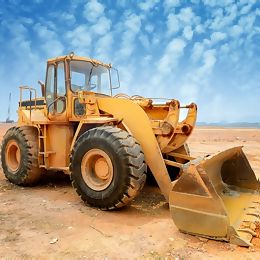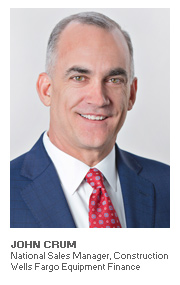
In early March, thousands of convention-goers descended on Las Vegas for CONEXPO, the largest construction equipment trade show in the world. It’s been three years since the last exposition, and a lot has changed in those years. One of the world’s most prolific builders, Donald Trump, now sits in the Oval Office. That has the construction sector abuzz with renewed optimism about what the new Presidential administration could mean for an industry still recovering from a crippling housing crisis and one of the worst recessions on record. With promises of an infrastructure spending boom on the horizon – and a “business friendly” regulatory environment taking shape – industry metrics show a renewed optimism among construction professionals.
According to Wells Fargo’s 2017 Construction Industry Forecast, contractors and equipment distributors have a positive outlook for 2017 – with optimism near the highest level in 20 years. Equipment Finance Advisor sat with John Crum, National Sales Manager for Wells Fargo’s Construction Group, to discuss the positive outlook for the construction industry in 2017 and beyond.
Equipment Finance Advisor: According to the recently released Wells Fargo 2017 Construction Industry Forecast, the Optimism Quotient (OQ) reached its third highest reading in twenty years – rising from 108 in 2016 to 123 for 2017. This survey was conducted immediately after the Presidential election (November 10th – December 2nd). What impact (if any) did the election results have on this increased optimism – considering the timing of the survey and promises made by President Trump related to increasing infrastructure spending?

John Crum: We purposely began the survey immediately after the election and extended the response period by a few extra days to capture the sentiment of a larger segment of the industry. As it pertains to the high level of optimism, we believe two things – first, optimism tends to move toward the positive after an election as some of the economic and political uncertainty is removed. Regardless of whether you are happy with the outcome or not, certainty brings with it a level of confidence. In terms of this election, there was an added degree of enthusiasm and excitement in the construction industry because of the focus on infrastructure spending by the President during the campaign. This enthusiasm has been expressed by our clients over the past few months and we also witnessed continued enthusiasm at CONEXPO (which ran from March 7 – 11, 2017). However increased spending is not the only factor boosting confidence; anticipated changes to the regulatory environment are also positively impacting confidence. Our customers believe a changing regulatory environment could be more conducive to expansion in the construction and infrastructure space in general, and contractors believe the future will provide a more “contractor friendly” environment.
Equipment Finance Advisor: Contractors are expecting industry expansion – with a majority (84%) expecting moderate to significant expansion in the next two years. This reflects a sharp rise from only 64% in last year’s survey. What is driving such a sharp increase in confidence among contractors (focusing on non-residential contractors)?
Crum: From the date the survey went out, to the conversations we had at CONEXPO, the industry players are feeling very bullish – particularly looking ahead to the two-year horizon. When we talk about infrastructure spending – whether it is large public infrastructure investment or large private infrastructure investment – 12 to 18 months is a reasonable horizon for infrastructure spending to make its way through the full process. Industry players are looking out two years, and many believe that while 2017 will be a good year, 2018 will be even better, and this two year positive outlook is impacting the OQ significantly.
Equipment Finance Advisor: The rental market remains strong as supported by the survey. However, the report also reflects a seemingly heightened sensitivity to rental rates among contractors – stating that an increase in rental rates as small as 5% could cause almost 20% of contractors to consider purchasing equipment. Does this level of sensitivity to rental pricing signal a potential philosophical shift back toward buying equipment (versus renting)?
Crum: The rental market remains strong, but this year we wanted to gain an understanding of how much rental rates would need to actually rise in order for equipment users to consider buying rather than renting equipment. We believe rental rates are at an equilibrium point – meaning there’s the right amount of rental equipment available in the market, along with the right amount of demand for rental equipment, and therefore rental pricing is accurately reflected in the market today. The survey results support that the market is at this equilibrium level given the fact that if the prices go up by only 5%, equipment users will consider buying rather than renting, as you stated. However, this also indicates that contractors have greater confidence in the industry as well as confidence in their balance sheets and profitability, which makes them less risk averse and also less ownership averse. Today, contractors will make a financial decision based on the cost of rental versus the cost of ownership while also considering convenience, economics and overall industry confidence. This is a shift from past years where there was stronger risk aversion from contractors after surviving the Great Recession. At that time they were more prone to rent than own.
Equipment Finance Advisor: Why would rental companies raise their rates now?
Crum: If the rental companies’ cost of running their businesses rises, they will need to raise rental rates. Additionally, if there was excess demand causing a scarcity of equipment supply, they could raise rates. But as of now, there has not been a large increase in rental rates that has flowed through to the contractors, and there’s still an adequate supply of high-quality rental equipment available. Strong competition exists among the rental shops, and there’s still a focus on market share and utilization. Lastly, a significant rise in interest rates would cause the cost of carrying these rental fleets to rise, leading to an eventual increase in rental rates. The factors that would cause an increase in rental rates have not yet materialized. The rental market seems to have “built in” the impact of a modest increase in interest rates at the end of 2016, so the rise in interest rates that has transpired thus far in 2017 hasn’t had a dramatic impact on rental rates.
Equipment Finance Advisor: Contractor backlogs are an important indicator of anticipated equipment requirements. Please provide our readers your insights into the current state of these project backlogs (non-residential). Additionally, in your opinion, what economic indicators are contractors and distributors watching closely to help them determine their required equipment investment requirements?
Crum: Many of our customers are saying their backlogs are as strong, or stronger, than this time last year. At Wells Fargo, in addition to our research, some of the indicators we watch closely include architectural building plans – which turned positive last month. We also monitor the Dodge Momentum Index – which is positive for February 2017, as well as indicators reflecting state and local spending, tax revenue and tax collections. From the contractors’ perspective, they watch what is most important to them, depending on what type of contractor they are and where they are located geographically. For example, if a contractor is a highway builder located in Pennsylvania, they are monitoring highway projects in Pennsylvania – so it’s a much more local perspective. On a national basis, we believe construction spending will be up overall, and contractors often monitor residential housing starts as a driver of this growth, because a big portion of building activity follows residential construction – even if it is not residential construction, such as streets and roads to get to the residential developments, shopping centers, schools etc. Overall we believe construction spending will be up this year, but the level of this growth depends on the particular construction segment, as some will be up more than others, and certain types may be down.
Equipment Finance Advisor: From your perspective, how will the rising interest-rate environment impact demand for construction equipment purchases during in the next 12 to18 months – considering it has been years since interest rates have moved upwards?
Crum: Any time there is a threatened interest rate hike, certain businesses that are highly sensitive to rising interest rates will move to buy equipment or to lock in lower rates. A rising interest-rate environment can sometimes stimulate buying activity both during the actual interest rate hikes and immediately after the interest rates rise.
Equipment Finance Advisor: According to your report, many contractors are continuing to buy used equipment. What is driving these contractors to buy used equipment considering the higher costs of maintaining this equipment?
Crum: Price is certainly a driving factor as the cost for used equipment is considerably more affordable than new. Additionally the quality and longevity of equipment that is sold and utilized today in North America is much better quality than it was 20 or 30 years ago – so contractors get more life and longevity from equipment than they were getting in the past. This is true almost across the board, regardless of the manufacturer. The quality of the equipment is superior today and there are very few contractors we work with that exclusively purchase new equipment. Most buy a mix of new and used equipment and we finance both new and used equipment every day.
Equipment Finance Advisor: Overall, how would you describe your outlook for the construction industry for 2017?
Crum: We have a very positive outlook and believe this industry will be strong in 2017. The industry performance as it relates to the buying and selling of new and used equipment and the financing of that equipment tends to reflect the general path of the Optimism Quotient movements on a directional basis. With this being the third highest OQ in the last twenty years, we feel very good about 2017, and the feedback was received at from CONEXPO confirmed this outlook.